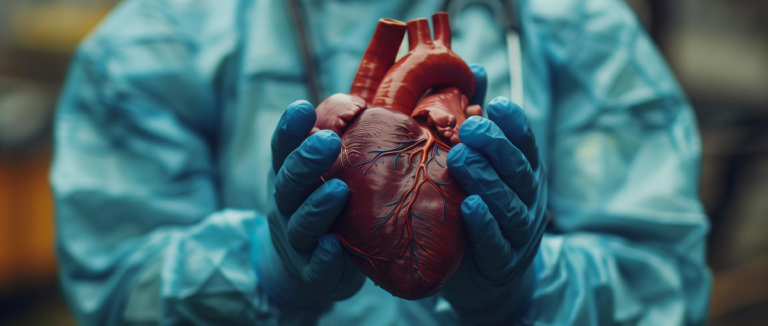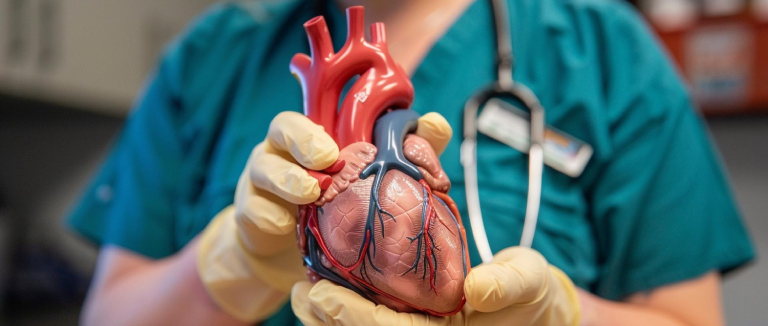Tricuspid Valve: Function, Importance, and Common Disorders
The tricuspid valve is a three-leafed valve located on the right side of the heart, regulating the opening between the right atrium and the right ventricle. This valve allows blood to flow only from the right atrium to the right ventricle and closes when the right ventricle contracts, preventing blood from flowing backward. The tricuspid valve plays a critical role in ensuring the heart pumps blood efficiently; any dysfunction or disease can significantly affect heart function.

Tricuspid Valve Diseases
Tricuspid valve disease occurs due to dysfunction of the tricuspid valve, which is located between the right atrium and the right ventricle. This valve ensures the one-way flow of blood and prevents blood from flowing backward. However, for various reasons, the valve may become damaged or fail to function properly.
Tricuspid valve diseases are conditions that affect the blood flow in the heart due to functional impairments of the tricuspid valve. These diseases are generally classified into two main types:
1. Tricuspid Insufficiency (Regurgitation):
Tricuspid insufficiency, also known as tricuspid regurgitation, occurs when the tricuspid valve fails to close properly between the right atrium and right ventricle. As a result, blood leaks backward from the right ventricle into the right atrium. This backflow disrupts normal blood circulation, places extra stress on the right side of the heart, and can eventually lead to heart failure if not managed appropriately.
Causes:
- Rheumatic heart disease
- Heart failure
- Congenital heart defects
- Endocarditis (inflammation of the heart lining)
- Structural abnormalities of the tricuspid valve
- Pulmonary hypertension (high blood pressure in the lungs)
Symptoms:
- Shortness of breath
- Swelling in the ankles
- Fatigue
- Abdominal fluid buildup (ascites)
- Rapid heart rate or palpitations
2. Tricuspid Stenosis:
Tricuspid stenosis occurs when the tricuspid valve becomes narrowed, making it difficult for blood to flow from the right atrium to the right ventricle. This narrowing restricts the passage of blood into the right ventricle, causing blood to accumulate in the right atrium. As a result, extra pressure builds up on the right side of the heart, potentially leading to further complications if left untreated.
Causes:
- Rheumatic heart disease
- Congenital heart defects
- Heart muscle diseases
- Endocarditis
Symptoms:
- Shortness of breath
- Fatigue
- Abdominal swelling (ascites)
- Dizziness
- Heart rhythm disorders
3. Tricuspid Valve Prolapse:
Tricuspid valve prolapse occurs when the valve fails to close properly and bulges backward into the right atrium as blood moves from the right atrium to the right ventricle. This condition typically results from either overstretching of the right ventricle or structural abnormalities of the valve. Tricuspid valve prolapse usually causes mild or minimal symptoms.
Causes:
- Connective tissue diseases
- Genetic predisposition
- High blood pressure
Symptoms:
- Mild or unnoticeable symptoms
- Heart failure symptoms in advanced cases
4. Endocarditis (Tricuspid Valve Infection):
The tricuspid valve can become infected by bacteria or viruses, a condition known as endocarditis. This infection can damage the valve and interfere with the function of the heart's right side. Tricuspid valve infection is more common in individuals who use intravenous (IV) drugs or have a history of heart valve disease.
Symptoms:
- Fever
- Shortness of breath
- Fatigue
- Changes in heart sounds
- Signs of infection
5. Congenital Tricuspid Anomalies:
Some individuals are born with congenital tricuspid valve anomalies. These anomalies cause structural defects in the tricuspid valve, which can lead to blood flowing backward (regurgitation) or difficulty in blood flow (stenosis).
Tricuspid valve diseases are often seen alongside other heart diseases and can lead to serious heart problems if left untreated. Treatment options depend on the type and severity of the disease, as well as the patient's overall health. These options may include medication, surgical interventions, or valve repair.
The tricuspid valve, located between the right atrium and right ventricle, ensures one-way blood flow. Tricuspid valve diseases occur due to dysfunction of this valve and are generally classified into stenosis, insufficiency, and prolapse.

What is a Tricuspid Clip?
A tricuspid clip procedure involves placing a small clip on the tricuspid valve, which is located between the right atrium and right ventricle of the heart. This valve controls blood flow on the heart's right side and prevents backward leakage (regurgitation). The procedure is most commonly used to treat tricuspid regurgitation (TR), helping the valve close more effectively and improving overall heart function.
When is the Tricuspid Clip Procedure Performed?
The tricuspid clip procedure is typically recommended in these situations:
- Tricuspid Regurgitation (TR):
- This occurs when the tricuspid valve does not close properly, causing blood to flow backward. TR can prevent effective blood pumping on the right side of the heart, leading to heart failure symptoms.
- Chronic Heart Failure:
- TR is a common complication in individuals with heart failure. The leakage of the tricuspid valve strains the right side of the heart and can worsen heart failure. The tricuspid clip procedure may be a treatment option to manage this condition.
- Severe TR:
- Severe TR can exacerbate the symptoms of right heart failure, leading to fluid retention in the body, shortness of breath, fatigue, and swelling in the legs.
- Surgical Intervention Required:
- If TR reaches a stage that cannot be corrected with other treatment methods or is a serious condition requiring surgical intervention, the tricuspid clip procedure may be applied.
The tricuspid clip procedure is most often performed as a surgical intervention, but minimally invasive approaches may also be used in some cases. The chosen method depends on the severity of tricuspid regurgitation (TR) and the patient overall health status.
How is the Tricuspid Clip Procedure Performed?
The tricuspid clip procedure is most often performed using a minimally invasive, percutaneous (through the skin) technique, which avoids large incisions. This approach repairs the tricuspid valve on the right side of the heart, helping to restore proper blood flow and address the problems caused by tricuspid regurgitation (TR).
Steps of the Tricuspid Clip Procedure:
- Preparation and Anesthesia: The patient is typically given local anesthesia and sedation to ensure comfort during the procedure. In rare cases, general anesthesia may be required.
- Catheter Access: A small incision is made in either the groin or wrist, allowing a catheter to be inserted into a large blood vessel and guided to the heart.
- Use of X-ray and Echocardiography: Fluoroscopy (live X-ray imaging) and echocardiography (heart ultrasound) guide the doctor in visualizing the tricuspid valve and ensuring precise placement of the clip.
- Placing the Clip: The doctor carefully positions a small clip on the tricuspid valve using the catheter. The clip draws the two leaflets of the valve closer together, promoting proper closure and reducing regurgitation.
- Control and Evaluation: After the clip is in place, echocardiography and X-ray confirm correct positioning and proper valve function. Adjustments to the position can be made if necessary.
- Post-Procedure: Following the procedure, the patient is monitored. Most patients remain in the hospital only for a few hours, as recovery time is typically brief with this minimally invasive approach.

What Are the Advantages of the Tricuspid Clip Procedure?
- Minimally invasive technique: The procedure is much less invasive than open heart surgery. The catheter is inserted through the groin to reach the heart, leading to faster recovery and a shorter hospital stay.
- Lower risk: Compared to open heart surgery, the tricuspid clip procedure has fewer risks, making it safe ” especially for elderly patients and those with other health conditions.
- Effective treatment: This procedure significantly reduces tricuspid valve insufficiency, improving symptoms and overall quality of life.
- Quick recovery: Most patients can be discharged the day after the procedure and return to normal activities soon.
- Less pain: Patients experience far less discomfort during and after the procedure compared to open heart surgery.
- Hope for those who do not respond to medication: For patients who don't see results with medication, the tricuspid clip offers a promising alternative.
- Improved quality of life: After this procedure, most patients notice significantly reduced symptoms and a better overall quality of life.
* Liv Hospital Editorial Board has contributed to the publication of this content .
* Contents of this page is for informational purposes only. Please consult your doctor for diagnosis and treatment. The content of this page does not include information on medicinal health care at Liv Hospital .
For more information about our academic and training initiatives, visit Liv Hospital Academy
Frequently Asked Questions
What does the tricuspid valve do?
It helps blood move from the right atrium to the right ventricle and prevents it from leaking backward when the heart pumps.
What causes tricuspid valve problems?
They can result from heart failure, infections, congenital defects, pulmonary hypertension, or damage to the valve structure.
What symptoms suggest a tricuspid valve disorder?
Shortness of breath, swelling in the legs or abdomen, fatigue, and irregular heartbeat can all be signs.
What is a tricuspid clip?
It is a small device placed on the valve through a catheter to help the valve close better and reduce leakage.
Who may need a tricuspid clip?
People with moderate to severe tricuspid regurgitation who still have symptoms despite medication and are not suitable for open heart surgery.
How long is recovery after a tricuspid clip?
Most patients go home the next day and resume light daily activities shortly after.
Are there risks with the tricuspid clip procedure?
Possible risks include bleeding, arrhythmias, infection, or incomplete improvement, though these are uncommon with experienced teams.




